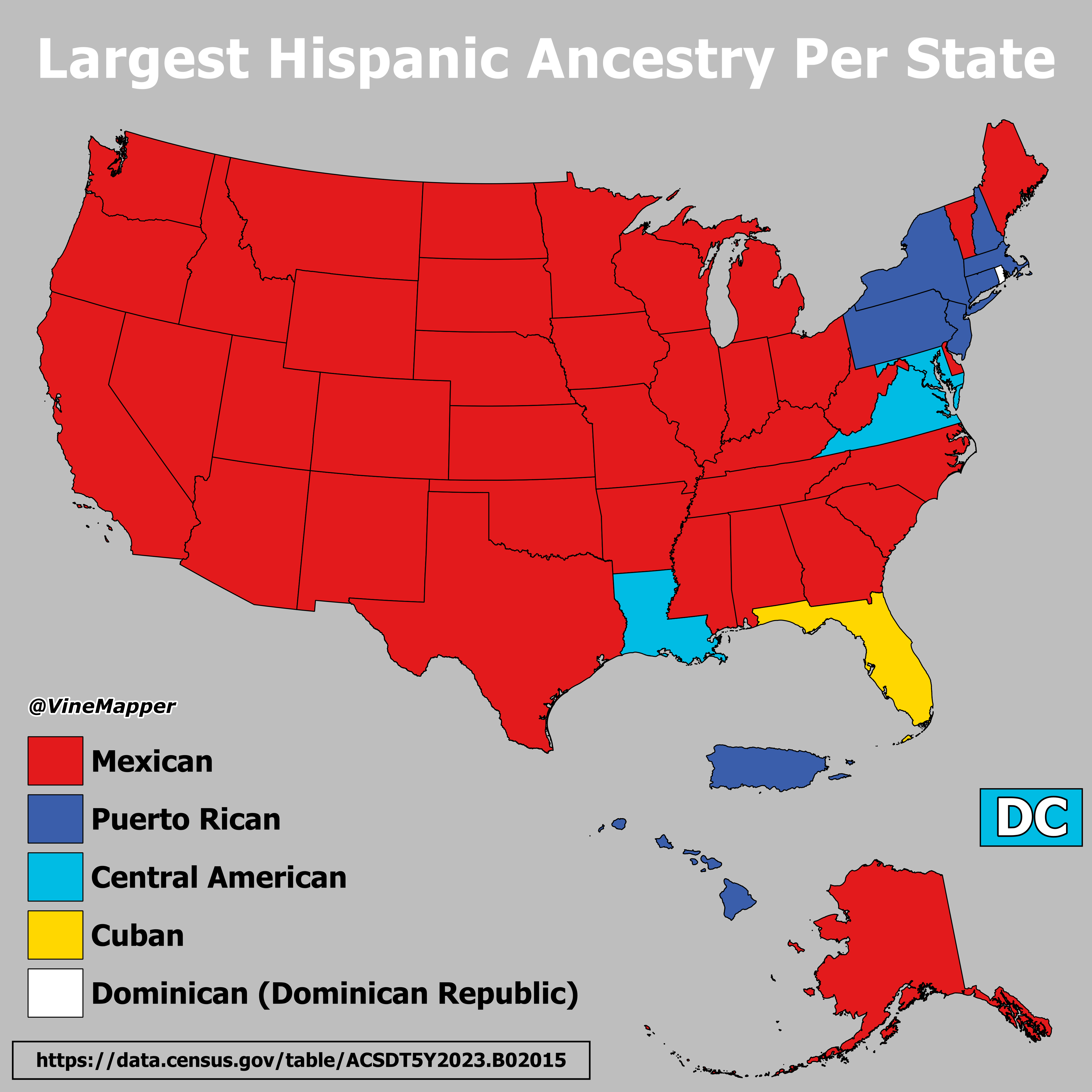Largest Hispanic Ancestry Per State Map


David Chen
Data Visualization Specialist
David Chen is an expert in transforming complex geographic datasets into compelling visual narratives. He combines his background in computer science ...
Geographic Analysis
What This Map Shows
The "Largest Hispanic Ancestry Per State Map" provides a detailed visualization of Hispanic ancestry across the United States, showcasing the predominant Hispanic groups in each state. This map not only highlights the diverse tapestry of cultures that make up the Hispanic community in the U.S. but also serves as a window into the historical migration patterns and socio-economic dynamics that have shaped these populations.
As we delve deeper into the topic of Hispanic ancestry in the United States, we can observe how these populations have grown and evolved over the decades, significantly contributing to the nation's cultural landscape.
Deep Dive into Hispanic Ancestry
Hispanic ancestry in the United States is a rich and complex subject, reflecting centuries of migration, colonization, and cultural fusion. The term "Hispanic" encompasses a wide range of nationalities and cultures, including but not limited to Mexican, Puerto Rican, Cuban, Dominican, and Central American ancestries. According to the U.S. Census Bureau, as of 2020, approximately 18.7% of the U.S. population identifies as Hispanic or Latino, a demographic that has steadily increased over the past several decades.
Among the states, California stands out with the largest Hispanic population, with Mexican ancestry being the most prevalent group. In fact, nearly 39% of California's population identifies as Hispanic, which is a reflection of the state’s historical ties to Mexico and its geographical proximity. Similarly, Texas also has a significant Hispanic population, where Mexican Americans comprise a substantial part of the state's demographic fabric.
Interestingly, Florida has a large Cuban population, especially in areas like Miami, which has become a cultural hub for Cuban Americans. This distinction is vital as it highlights the different Hispanic ancestries that dominate in various states, influenced by migration trends and historical events such as the Cuban Revolution.
Moreover, the Dominican community is particularly prominent in states like New York, where they have established vibrant neighborhoods and cultural institutions. The Dominican Republic's proximity to the U.S. and the historical migration patterns following the political turmoil of the 20th century have led to this concentration.
This diversity in ancestry is not just about numbers; it also brings various cultural, religious, and social practices that enrich the broader American culture. Festivals, culinary traditions, and linguistic contributions are just a few examples of how Hispanic ancestry shapes local and national identities.
Regional Analysis
Breaking the map down regionally allows us to appreciate the variations in Hispanic ancestry across the United States. In the Southwest, particularly in states like Arizona and New Mexico, the Mexican ancestry predominates, reflecting a long history of intermingling before the U.S.-Mexico border was drawn. Here, traditional Mexican cultural practices remain vibrant, influencing local cuisine, music, and art.
In contrast, the Northeast, particularly in states like New York and New Jersey, showcases a different Hispanic demographic. The Puerto Rican and Dominican communities are more prevalent here, with their unique cultural influences evident in city life, from the vibrant street festivals to the rich culinary scene.
The Midwest, while historically less associated with Hispanic populations, has seen an increase in Mexican communities in states like Illinois and Michigan. This shift can be attributed to labor migration patterns in the late 20th century, where many sought employment in industries such as agriculture and manufacturing.
Lastly, the impact of Hispanic ancestry is also noticeable in the Southeast, particularly in Florida, where the Cuban community has significantly influenced the state’s culture and politics. The historical context of the Cuban Revolution and subsequent migrations led to a robust community that has left an indelible mark on Florida's identity.
Significance and Impact
Understanding the landscape of Hispanic ancestry in the United States is crucial for several reasons. Firstly, it sheds light on the changing demographic trends that will shape the future of the nation. As the Hispanic population continues to grow, their influence on politics, economics, and culture becomes increasingly significant.
Moreover, recognizing the diverse backgrounds within the Hispanic community can foster greater social cohesion and understanding. It’s important to move beyond monolithic representations and appreciate the unique narratives each subgroup brings to the table.
Current trends indicate that the Hispanic population will continue to expand, with younger generations becoming more politically active and influential. This demographic shift will likely have profound implications on policies related to education, immigration, and healthcare, highlighting the need for inclusive strategies that address the needs of diverse communities.
In conclusion, the "Largest Hispanic Ancestry Per State Map" not only serves as a tool for visualizing demographic distributions but also invites us to engage with the rich histories and cultures that shape the Hispanic experience in the United States today. As we move forward, it’s vital to celebrate this diversity and recognize its integral role in shaping the American identity.
Visualization Details
- Published
- August 12, 2025
- Views
- 92
Comments
Loading comments...